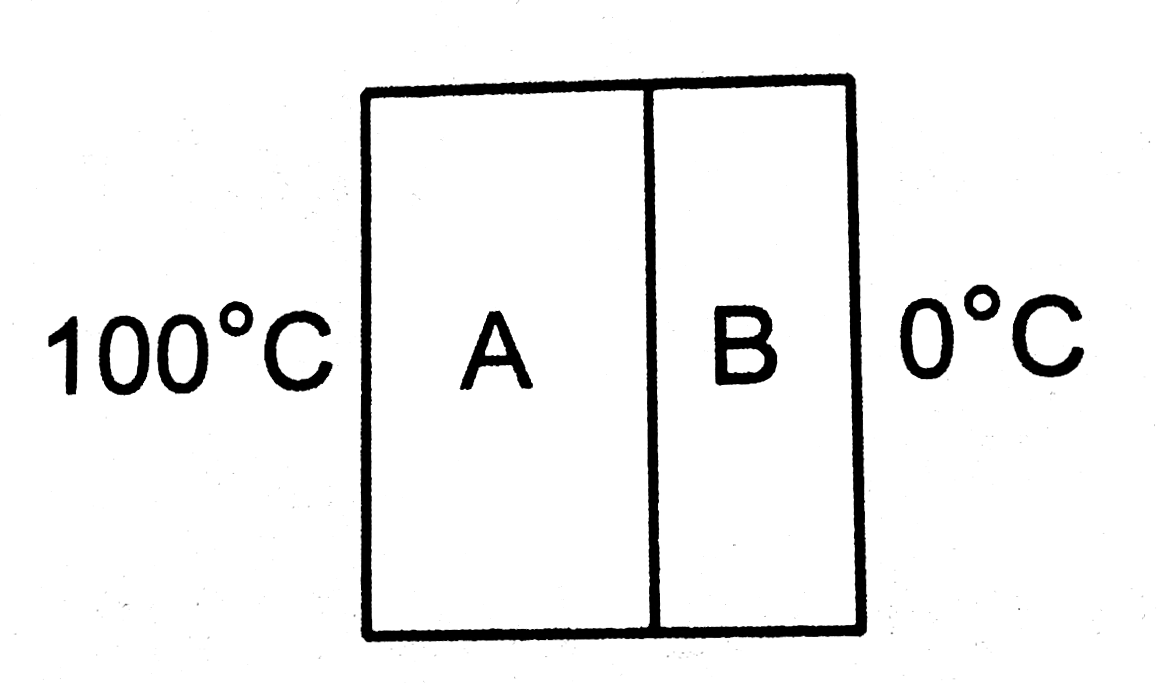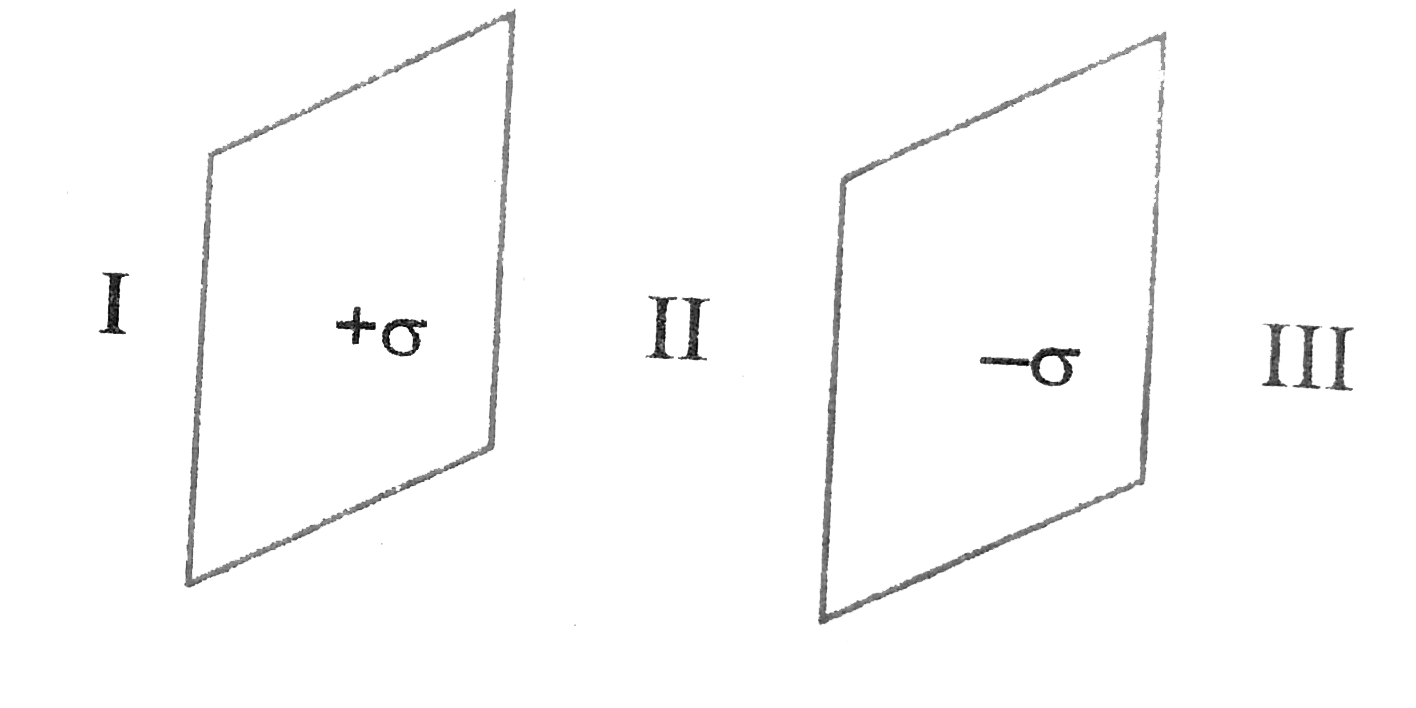Two parallel plates A and B are joined together to form a compound plate . The thicknesses of the plate are 4.0cm and 2.5cm respectively and the area of cross section is 100cm2 for each plate. The thermal conductivities are KA=200Wm−1C−1 for plate A and KB=400Wm−1C−1 for the plate B. The outer surface of the plate A is maintained at100∘C and the outer surface of the plate B is maintained at 0∘C. Find (a) the rate of heat flow through any cross section, (b) the temperature at the interface and (c) the equivalent thermal conductivity of the compound plate.
 Solution in Tamil
Solution in Tamil
Let the temperature of the interface be theta. The area of cross section of each plate is A=100cm2=0.01m2 .The thicknesses are x_(A)=0.004mandx_(B)=0.025m.
The thermal resistance of the plate A is R1=1KAxAA .and that of the plate B is R2=1KBxBA . The equivalent thermal resistance is
R=R_(1)+R_(2)=(x_(A)/K_(A)+x_(B)/(K_(B))).thus,(DeltaQ)/(Deltat)=(theta_(1)-theta_(2))/(R).=(Atheta_(1)-theta_(2))/(x_(A)//K_(A)+x_(B)//K_(B)).((0.01m^(2))((100^(@)C)))/((0.04m)//(200Wm^(-1)^(∘)C−1)+(0.025m)/(400Wm−1^(@)C^(-1))).=3810W.(b)Wehave(DeltaQ)/(Deltat)=(A(theta-theta_(2)))/(x_(B)//K_(B)).or,3810W=((0.01m^(2))(theta-0^(@)C))/((0.025m)(200Wm^(-1)^(∘)C−1)+(0.025m)/(400Wm−1^(@)C^(-1))).or,theta=24^(@)C.(c)IfKisthe≡a≤ntthermalconductivityofthecompoundplate,itsthermalresistanceis<br>R=(1)/(A)(x_(A)+x_(B))/(K).Compar∈gwith(i)(x_(A)+x_(A))/(K)=(x_(A))/(K_(A))+x_(B)/(K_(B)).or,K=(x_(A)+x_(B))/(x_(A)//K_(A)+x_(B)//K_(B)).=248Wm^(-1)^(∘)C−1 .
Topper's Solved these Questions
- BOOK - HC VERMACHAPTER - HEAT TRANSFEREXERCISE - QUESTIONS FOR SHORT ANSWER11videos
HEAT TRANSFER
- BOOK - HC VERMACHAPTER - HEAT TRANSFEREXERCISE - OBJECTIVE I10videos
HEAT TRANSFER
- BOOK - HC VERMACHAPTER - HEAT TRANSFEREXERCISE - EXERCIESE55videos
HEAT TRANSFER
- BOOK - HC VERMACHAPTER - HEAT AND TEMPERATUREEXERCISE - Exercise34videos
HEAT AND TEMPERATURE
- BOOK - HC VERMACHAPTER - INTRODUCTION TO PHYSICSEXERCISE - Exercises19videos
INTRODUCTION TO PHYSICS
Similar Questions
The heat current is written as ΔQΔt . Why don't we write dQdt ?
07:50View SolutionThe thermal conductivity of a rod depends on
02:26View SolutionA uniform slab of dimension 10cm×10cm×1cm is kept between two heat reservoir at temperatures 10∘C and 90∘C. The larger surface areas touch the reservoirs. The thermal conductivity of the material is 0.80Wm−1C−1 . Find the amount of heat flowing through the slab per minute.
03:00View SolutionThe steam point and the ice point of a mercury thermometer are marked as 80∘C and 20∘C. What will be the temperature in centigrade mercury scale when this thermometer reads 32∘C?
03:12View SolutionFind the dimensions of
a. linear momentum
b. frequency and
c. pressure01:58View SolutionTwo parallel plates A and B are joined together to form a compound plate . The thicknesses of the plate are 4.0cm and 2.5cm respectively and the area of cross section is 100cm2 for each plate. The thermal conductivities are KA=200Wm−1^(@)C^(-1)forthepa<eB.TheoutersurfaceoftheplateAisma∫a∈≠dat100^(@)CandtheoutersurfaceoftheplateAisma∫a∈edat100^(@)C . and the outer surface of the plate B is maintained at 0^(@)C. Find (a) the rate of heat flow through any cross section, (b) the temperature at the interface and (c) the equivalent thermal conductivity of the compound plate.
 04:52View Solution
04:52View SolutionFind the capacitance between A and B if two dielectric alabs (each of area A ) of dielectric constants K_(1) and K_(2) and thicknesses d_(1) and d_(2) are inserted between the plates of a parallel plate capacitor of plate area A . .
View SolutionTwo large this metal plates are parallel and close to each other. On their inner faces, the plates have surface charge densities of opposite signs and magnitude 17.0×10−22C/m2. What is →E : in the outer region of the first plate. (b) in the outer region of the secound plate, and (c) between the plates ? See Fig.
 03:56View Solution
03:56View SolutionIf two metallic plates of equal thickness and thermal conductivities K_(1) and K_(2) are put together face to face and a common plate is constructed, then the equivalent thermal conductivity of this plate will be
05:40View SolutionThree plates A, B and C are placed close to each other with +Q charge given to the middle plate. The inner surfaces to A and C can be connected to earth through plate D and keys K_(1) and K_(2) . The plates D is a dielectric slab with dielectric constant K_(1) then the charge that will flow through plate D and keys K_(1) and K_(2) . The plate D is a dielectric slab with dielectric constant K, then the charge that will flow though plate D when K_(2) is closed and K_(2) is open is
04:16View SolutionTwo large, thin metal plates are parallel and close to each other. On their inner faces, the plates have surface charge densities of opposite sign and of magnitude 17.0×10−11C/m2. What is E
(a) in the outer region of the first plate,
(b) in the outer region of the second plate, and (c) between the plates?View SolutionTwo large thin metal plates are parallel and close to each other on their inner faces the plates have surface charges densites of opposite region of the first plate (b) in the outer region of the second plate and (c ) between the plates
05:40View SolutionTwo large thin metal plates are parallel and close to each other on their inner faces the plates have surface charges densites of opposite region of the first plate (b) in the outer region of the second plate and (c ) between the plates
04:52View SolutionTwo large, thin metal plates are parallel and close to each other. On their inner faces, the plates have surface charge densities of opposite signs and magnitude 17.0×10−22Cm−2. What is the electric field
a. in the outer region of the first and the second plates?
b. between the plates?03:10View SolutionTwo large this metal plates are parallel and close to each other. On their inner faces, the plates have surface charge densities of opposite signs and magnitude 17.0×10−22C/m2. What is →E : (a) In the outer region of the first plate. (b) In the outer region of the secound plate, and (c) Between the plates ? See Fig.
 07:04View Solution
07:04View SolutionTwo large, thin metal plates are parallel and close to each other , On their inner faces, the plates have surface charges densities of opposite signs and of magnitude 17.0×10−22C/m2.What is →E :
in the outer region of the first plate,
(b) in the outer region of the second plate,
(c) between the plates?07:04View Solution

